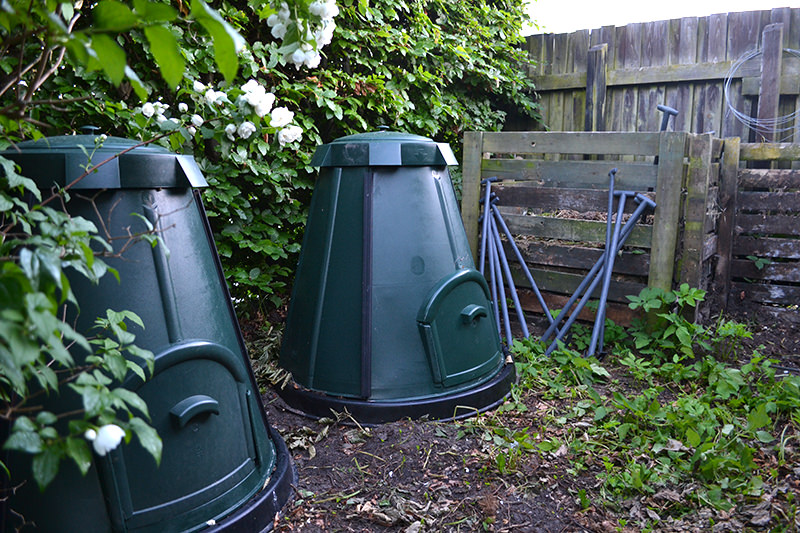

Natural Resources Conservation
Themed landscapes, such as alpine gardens, bog gardens, rain gardens or xeriscapes, work with soils that are at the extremes of alkalinity, acidity and water saturation, and accordingly rely on both careful plant selection and a working knowledge of soil chemistry and ecology. For your average temperate-zone gardener of edible crops, however, a basic fertile humus soil is what makes or breaks a garden. Building this productive, black soil from scratch takes time and energy, but in this age of rampant soil depletion and concurrent abundance of both food waste and wastewater, it’s a deceptively easy endeavor.
Humus achieves its characteristic black or dark brown color because it’s high in carbon matter. This means it is mostly or exclusively comprised of decayed or decaying organic material, from both plants and animals. A carbon-rich organic humus provides myriad ecological services to an area of cultivation, ranging from increased biodiversity in the soil life web, support and nourishment of mycelial networks, absorption and breakdown of pollutants, increased water retention, and increased nutrient bioavailability and storage.
Instead of purchasing this invaluable commodity, with a few easy best practices, you can make organic soil-building a part of your daily gardening.
Step 1: Make And Implement A Composting Plan

Lynsey Grosfield
Biodegradable household waste runs the gamut from eggshells and vegetable food waste to paper and cardboard. In a sealed compost system, even meat, dairy and pet waste can be disposed of organically—these systems should have a volume of more than 35 cubic feet (about 1 cubic yard), so it can achieve one of the following internal temperatures to kill pathogens:
- 144 degrees F for one hour
- 122 degrees F for one day
- 115 degrees F for one week
- 109 degrees F for one month
Composting methods can be fast and aided by microbial or invertebrate decomposers. The Japanese bokashi bin, for example, uses a microbial culture packaged in a “bran,” which allows for rapid and scentless anaerobic decomposition. Vermicomposting or composting with the aid of black soldier flies take advantage of detritus-feeders’ appetites.
Composting systems can also be long-term, simply relying on the elements and aerobic decomposition in a mound, taking a few years to turn into humus. The best results come from turning the compost repeatedly in order to rotate the contents that are at the warm center of the heap.
Step 2: Mulch, Mulch And More Mulch

Lynsey Grosfield
Humus is basically an accumulation of broken-down plant and animal detritus: What better way to bulk up your soil than continually adding a top-dressing of organic matter? As the worms and other soil-dwelling organisms work on breaking down the top layer, they aerate and till the soil underneath.
Great mulches are high in carbon (“browns”), as high-nitrogen mixes (“greens”) can form anaerobic mats. Mixtures of bulk organic materials, like grass clippings, leaf litter, shredded paper and hair, create a long-lasting organic scaffold for the soil. Plant roots can intertwine in this matter and speed along decomposition, while the mixture holds water, nourishes fungi and suppresses weeds.
Step 3: Think Outside The Loo
Greywater—water that results from baths, showers, and washing clothes or dishes—is generally an excellent source of nutrients and biomass to the garden, showing little or no long-term impact on the health of plants that are irrigated with it. Assuming it has some pathogenic potential, it is best piped under the soil. Plants have an amazing capacity to turn all of the detergents, soaps and ammonia-like compounds in wastewater into nutrition. Even washing dishes in a basin and re-using the water to irrigate is a soil-enriching way of making greywater re-use a part of everyday life.
Beyond the conventional wastewater fare, even human urine has applications in cultivation. While it sounds a little odd to be going number one in the garden, urine is an admirably consistent source of three vital plant nutrients: nitrogen, phosphorous and potassium (you know, NPK—those three nutrients on a bag of commercial fertilizer). Considering that non-renewable phosphorous in particular is extracted for agricultural use at a totally unsustainable rate, pee-cycling becomes an attractive, 100-percent free and organic alternative.
From a healthy person, urine is more or less hygienic (although the talk that it’s sterile it is a myth). Farms in Vermont have already begun programs to use urine-based fertilizers on a massive scale. One part urine diluted with 10 parts water is an excellent fertilizer for trees, and can generally help in adding macro- and micronutrients to the topsoil.
Step 4: Make Weeds Into Tea

Lynsey Grosfield
The common dandelion and the common nettle are chock-full of trace minerals and micronutrients, which are merely thrown away in blue bags come time to weed the garden. Given that all the nutrients they accumulate come from the soil where they are pulled up, it’s a shame to cart them off.
Steeped in rainwater for a few days, these weeds can rot to the point where they will not self-sow again and can be dried to used as mulch or compost. The resultant “fragrant” nitrogen-rich mixture is a potent natural fertilizer. This returns hard-won mineral nutrition to the soil it came from instead of sending it off for disposal.
With a few good habits, creating rich organic topsoil can be a way to dispose of household, personal and yard waste, without ever carting it away. Once systems are established, you may even end up asking your neighbors for their blue-bagged goods; after all, there’s a reason good humus is called black gold.
About the Author: Lynsey Grosfield is the founder of BiodiverSeed, a global seed swap network devoted to the exchange of self-harvested, organic and heirloom seeds with the goal of preserving maximum genetic diversity. Follow BiodiverSeed on Twitter.




